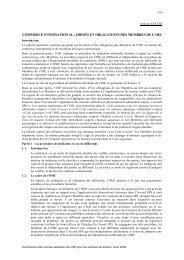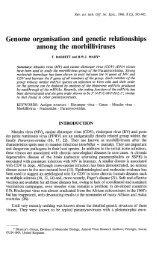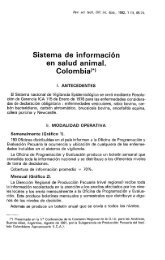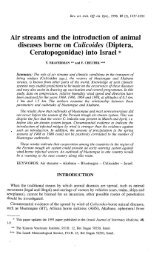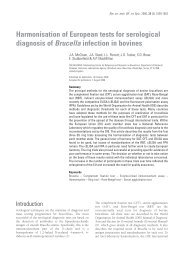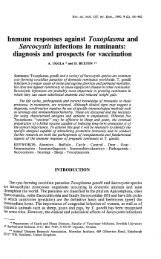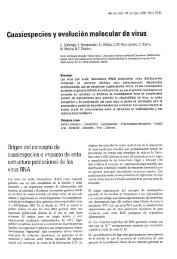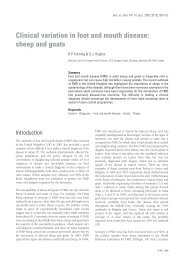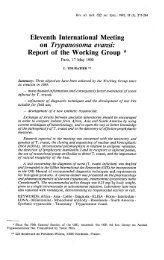26th Conference of the OIE Regional Commission for Asia
26th Conference of the OIE Regional Commission for Asia
26th Conference of the OIE Regional Commission for Asia
Create successful ePaper yourself
Turn your PDF publications into a flip-book with our unique Google optimized e-Paper software.
PSVS<br />
287. The highlights <strong>of</strong> activities <strong>of</strong> <strong>OIE</strong>/AusAID PSVS during this year were, holding <strong>of</strong> <strong>the</strong> 4th<br />
Steering Group meeting, organizing <strong>of</strong> <strong>the</strong> 1st Sub-<strong>Regional</strong> Workshop on Animal Health<br />
Communication, 2nd <strong>Regional</strong> Workshop on Veterinary Legislation and Governance, 2nd<br />
<strong>Regional</strong> Workshop on Emergency Preparedness and Response, co-organized with FAO <strong>the</strong><br />
sub-regional Workshop to Streng<strong>the</strong>n Laboratory Network <strong>for</strong> South East <strong>Asia</strong>, participation<br />
in <strong>the</strong> Per<strong>for</strong>mance <strong>of</strong> Veterinary Services (PVS) Gap analysis training at <strong>OIE</strong> headquarters<br />
in Paris and <strong>the</strong> evaluation <strong>of</strong> Veterinary Services in <strong>the</strong> Philippines using <strong>the</strong> PVS Tool.<br />
288. A new Program Coordinator , Dr John Stratton, was hired in April 2009 to manage <strong>the</strong><br />
project until it finishes next year.<br />
289. One <strong>of</strong> <strong>the</strong> major highlight this year is <strong>the</strong> evaluation <strong>of</strong> <strong>the</strong> project by an Independent Project<br />
Review (IPR) team contracted by AusAID. Among those that was closely examined was <strong>the</strong><br />
project goals and its component objectives. This project is aimed at helping countries in<br />
Sou<strong>the</strong>ast <strong>Asia</strong> to initially improve <strong>the</strong>ir current capacities in terms <strong>of</strong> veterinary legislation,<br />
emergency preparedness and risk communication. The project also aims to bring <strong>the</strong> VS into<br />
line with <strong>OIE</strong> international standards in terms <strong>of</strong> governance, organisation and programmes<br />
including active partnerships with <strong>the</strong> private sector as well as providing technical support<br />
<strong>for</strong> evaluation <strong>of</strong> <strong>the</strong> VS, primarily based on <strong>the</strong> <strong>OIE</strong> Terrestrial Animal Health Code and <strong>the</strong><br />
PVS Tool.<br />
290. Among <strong>the</strong> findings <strong>of</strong> <strong>the</strong> IPR team is <strong>the</strong> unique features <strong>of</strong> PSVS which has been <strong>the</strong> focus<br />
on systems development compared to <strong>the</strong> more typical donor engagement in technical issues<br />
and capacity building in technical areas. PSVS, through its work on improving <strong>the</strong> legislative<br />
environment <strong>for</strong> improved animal health systems, has ei<strong>the</strong>r stimulated some early activity<br />
in legislation, or has been a catalyst <strong>for</strong> increasing momentum in countries where some<br />
preliminary work had begun.<br />
291. The key recommendation <strong>of</strong> <strong>the</strong> IPR Team is to refocus <strong>the</strong> PSVS on enabling national<br />
governments to attract resources from industry, government, and donors to support and<br />
implement a coherent, costed, national plan to improve veterinary services. The aim <strong>of</strong> <strong>the</strong><br />
project at <strong>the</strong> national level <strong>the</strong>n becomes to increase <strong>the</strong> uptake <strong>of</strong> <strong>the</strong> PVS tool, and<br />
motivate engagement <strong>of</strong> a wide range <strong>of</strong> stakeholders in <strong>the</strong> development <strong>of</strong> this plan.<br />
292. The draft Conclusions and Recommendations <strong>of</strong> <strong>the</strong> Cambodia meeting on Communication<br />
was endorsed by <strong>the</strong> <strong>Regional</strong> <strong>Commission</strong>.<br />
Wednesday 18 November 2009<br />
Technical Item II<br />
The development <strong>of</strong> disease-free zones <strong>for</strong> equine diseases,<br />
including <strong>the</strong> example <strong>of</strong> China<br />
293. Dr Gardner Murray started his presentation by referring to <strong>the</strong> <strong>OIE</strong> <strong>of</strong>ficial freedom<br />
recognition procedures <strong>for</strong> Foot and Mouth Disease (FMD), Contagious Bovine<br />
Pleuropneumonia, Bovine Spongi<strong>for</strong>m Encephalopathy and Rinderpest.<br />
294. He explained that <strong>for</strong> all o<strong>the</strong>r diseases freedom is based on self-declaration if <strong>the</strong> country<br />
can provide sufficient evidence as provided in <strong>the</strong> relevant Code Chapter to substantiate its<br />
claims.<br />
39





